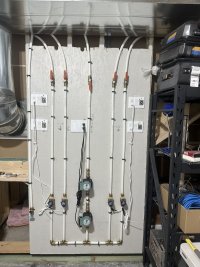Wondering if I can get some input on water velocity concerns from a pro on a redesign I did of my on-demand hot water recirculation system.
Originally I couldn't find anyone who could do what I wanted so I wound up building the system myself about four years ago. It's worked great but I always wished I could get faster hot water delivery which used to take 30 to 50 seconds depending on length of the branch. I've now cut that time by almost 1/2 with a redesign that includes putting two pumps in series.
I have momentary switches near faucets that initiate a timer and in turn starts a pump. It's a single story ranch with a big footprint and also has a basement. The hot water leaves the water heater (tank type) and splits off in four quadrants. The initial design had four Taco 006E3 pumps, one for each of the quadrants. The recirculation lines in turn come back and then join a common return to the cold water line on the water heater.
My redesign (see photo) simply uses two of the Taco pumps in series and are common to all of the zones. Each zone has a solenoid valve that's activated along with the pumps. The pumps are set to max speed which I'm aware would likely be problematic if they ran all the time, but I have the timers set for 20 - 25 seconds so obviously they don't spend a lot of time moving water. I do hear a hum when both pumps are running but not when only one is running. The noise doesn't seem to be from the pumps but from the pipes so I assume that's some sort of resonance from the water velocity in the pipes. So I'm wondering if that's a concern at all.
If there was some way I could measure the actual head of each zone I could probably do the calculations to determine optimal pump speed but I have no idea how to do that. But overall with the two pumps in series the system works as I hoped it would but I'm just concerned whether the MAX pump settings might be problematic in some way.
I appreciate any input on this.
Originally I couldn't find anyone who could do what I wanted so I wound up building the system myself about four years ago. It's worked great but I always wished I could get faster hot water delivery which used to take 30 to 50 seconds depending on length of the branch. I've now cut that time by almost 1/2 with a redesign that includes putting two pumps in series.
I have momentary switches near faucets that initiate a timer and in turn starts a pump. It's a single story ranch with a big footprint and also has a basement. The hot water leaves the water heater (tank type) and splits off in four quadrants. The initial design had four Taco 006E3 pumps, one for each of the quadrants. The recirculation lines in turn come back and then join a common return to the cold water line on the water heater.
My redesign (see photo) simply uses two of the Taco pumps in series and are common to all of the zones. Each zone has a solenoid valve that's activated along with the pumps. The pumps are set to max speed which I'm aware would likely be problematic if they ran all the time, but I have the timers set for 20 - 25 seconds so obviously they don't spend a lot of time moving water. I do hear a hum when both pumps are running but not when only one is running. The noise doesn't seem to be from the pumps but from the pipes so I assume that's some sort of resonance from the water velocity in the pipes. So I'm wondering if that's a concern at all.
If there was some way I could measure the actual head of each zone I could probably do the calculations to determine optimal pump speed but I have no idea how to do that. But overall with the two pumps in series the system works as I hoped it would but I'm just concerned whether the MAX pump settings might be problematic in some way.
I appreciate any input on this.

